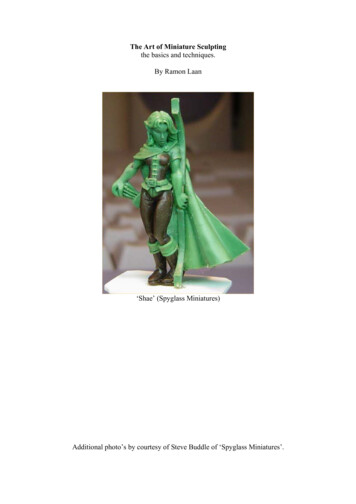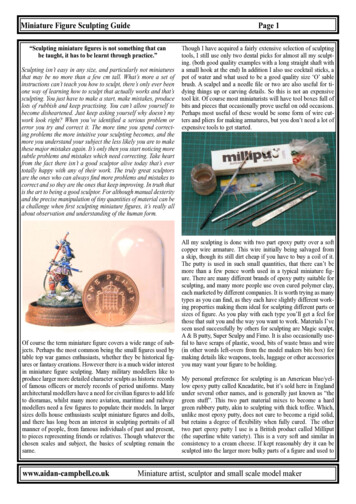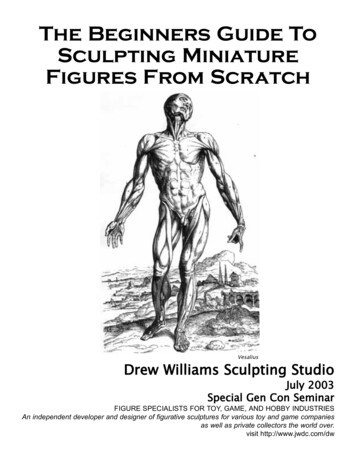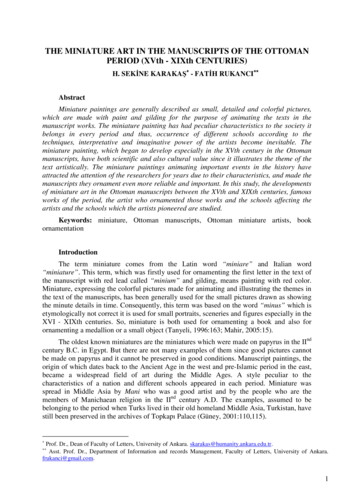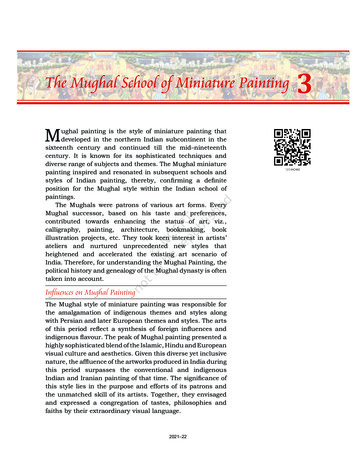
Transcription
The Mughal School of Miniature Painting3Mughal painting is the style of miniature painting thatdeveloped in the northern Indian subcontinent in thesixteenth century and continued till the mid–nineteenthcentury. It is known for its sophisticated techniques anddiverse range of subjects and themes. The Mughal miniaturepainting inspired and resonated in subsequent schools andstyles of Indian painting, thereby, confirming a definiteposition for the Mughal style within the Indian school ofpaintings.The Mughals were patrons of various art forms. EveryMughal successor, based on his taste and preferences,contributed towards enhancing the status of art, viz.,calligraphy, painting, architecture, bookmaking, bookillustration projects, etc. They took keen interest in artists’ateliers and nurtured unprecedented new styles thatheightened and accelerated the existing art scenario ofIndia. Therefore, for understanding the Mughal Painting, thepolitical history and genealogy of the Mughal dynasty is oftentaken into account.Influences on Mughal PaintingThe Mughal style of miniature painting was responsible forthe amalgamation of indigenous themes and styles alongwith Persian and later European themes and styles. The artsof this period reflect a synthesis of foreign influences andindigenous flavour. The peak of Mughal painting presented ahighly sophisticated blend of the Islamic, Hindu and Europeanvisual culture and aesthetics. Given this diverse yet inclusivenature, the affluence of the artworks produced in India duringthis period surpasses the conventional and indigenousIndian and Iranian painting of that time. The significance ofthis style lies in the purpose and efforts of its patrons andthe unmatched skill of its artists. Together, they envisagedand expressed a congregation of tastes, philosophies andfaiths by their extraordinary visual language.2021–221 3.Mughal School Folder.indd 3501 Sep 2020 02:15:59 PM
36An Introduction to Indian Art —Part IIIn the Mughal courts, arts became more formalised asthere were workshops and many artists were brought fromIran, which resulted in a harmonious blend of Indo-Iranianstyles, especially during its early years. This celebratedeminence in Mughal art was possible only due to its distinctivecharacter of assimilating and engaging artists of both Indianand Iranian origins, who contributed towards making, andfurther elevating the artistic paradigm of the Mughal style.The Mughal atelier consisted of calligraphers, painters, gildersand binders. Paintings recorded and documented significantevents, personalities and interests of the emperors. These weremeant to be seen by the royals only. The paintings were madeto suit the sensitivity of the royals or often made as intellectualstimulation. The paintings were a part of manuscriptsand albums.The tradition of art and painting had rich historical rootsin India about which we have already learned in the previouschapters. The celebrated Mughal idiom that developed onthe Indian soil should be understood as a consequence ofinteraction of various schools, including the pre–Mughaland contemporaneous art schools of India and Persia. Thus,the Mughal style did not grow in vacuum. It was nurturedby direct interaction with other art forms and schools thatalready existed. The indigenous Indian and Mughal paintingstyles coexisted, assimilated the influences and variousnative talents in different ways.The pre–Mughal and parallel indigenous schools of paintingsin India had their strong distinct style, aesthetics andpurpose. The indigenous Indian style emphasised on flatperspective, strong use of lines, vivid colour palette, and boldmodelling of figures and architecture. The Mughal style offeredsubtlety and finesse, portrayed almost three-dimensionalfigures and created optical reality. The royal court scenes,portraits, depiction of accurate flora and fauna were some ofthe favourite themes of the Mughal artists. Thus, the Mughalpainting ushered in a new style and sophistication to theIndian arts of that time.The Mughal patrons contributed to the proliferationof the Mughal style of painting with their distinct artisticpreferences, choice of subjects, philosophies and aestheticsensibilities. In the following segment of this chapter, we shalllearn about the development of Mughal miniature painting inchronological order.2021–221 3.Mughal School Folder.indd 3601 Sep 2020 02:15:59 PM
The Mughal School of Miniature Painting37Early Mughal PaintingIn 1526, Babur, the first Mughal emperor, came from presentday Uzbekistan and was a descendent of Emperor Timurand Chatghtai Turk. With this, he blended the culturalbackground and aesthetic sensibilities of Persia and CentralAsia. Babur had a dynamic taste for a variety of arts. Heis reputed to be a man of letters and a keen patron of art,manuscripts, architecture, gardening, etc. Babur’s detailedaccounts in Baburnama, his autobiography, are narrativesof the emperor’s political carrier and artistic passion.Baburnama reflects the love and fondness that Babur had asan outsider for the Indian land and ecology. With his fervourfor detailed writing, Babur established a tradition of keepingmemoirs, a practice which was followed by his successorsin India. The books and albums that were produced in theroyal ateliers were not only calligraphed but also painted.These books of value were preserved and passed on tomembers of the royal family or gifted to those perceived asdeserving. Babur had a keen eye for portraiture and this isalso recorded in his memoirs. Among the artists, who findmention in Babur’s memoirs is Bihzad. Bihzad’s work wasPrinces of the House of Timur,Abd us Samad,1545–50, British Museum,London2021–221 3.Mughal School Folder.indd 3701 Sep 2020 02:16:00 PM
38Tutinama: The Girl andthe Parrot,1580–1585, ChesterBeatty Library, DublinAn Introduction to Indian Art —Part IIdainty but he did not draw the faces well; he used to greatlylengthen the double chin (ghab-ghab); and drew beardedfaces admirably. Bihzad was a master artist from the Persianschool of painting, Herat (now in present day Afghanistan),and was known for his sophisticated compositions andcolour tints. Also, Shah Muzaffar finds a mention as apainter, who Babur thought excelled in the representationof hairstyle. Although Babur spent little time on the Indiansoil and passed away soon after his arrival, his successorsmade the country their own and became a part of theIndian lineage.Babur was succeeded by his son Humayun in 1530, whounfortunately fell prey to political unrest, and his life tookmany unexpected turns. Dethroned by an Afghan, Sher Khan(Sher Shah), Humayun took refuge in the court of the SafavidPersian ruler, Shah Tahmasp. Although inglorious for hispolitical career, this was fortunate for the startling turnthat the art of manuscript and painting under him took as aresult of his stay in Safavid. It was during his exile in ShahTahmasp’s court that Humanyun witnessed the magnificentartistic tradition of miniature paintings and manuscripts. Hewas thrilled to see the skillful artists in practice, creatingsplendid works of art for Shah Tahmasp. With the assistanceof Shah Tahmasp, Humayun established hiscourt in Kabul in 1545. Humayun increasinglyidentified himself with a political and culturalagenda for his dynastic empire that waseclectic and assimilative. Impressed by theartists and with an ambition to recreate suchart workshops in India, Humayun broughtback with him the master artists when heregained power in India. He invited two Persianartists — Mir Sayyid Ali and Abd us Samadto establish a studio in his court and carryout royal paintings. It is important to notehere that both the artists were famous andrespected particularly for their skills in the artof portraiture.A bibliophile of discerning sensitivity,Humayun’s rule began a period of intensepatronage for the art of painting andcalligraphy. From his period, we get clear visualand textual documents that testify an active2021–221 3.Mughal School Folder.indd 3801 Sep 2020 02:16:00 PM
The Mughal School of Miniature Painting39interest in building an artistic repertoire and an imperialatelier. This is an indication of Humayun’s artistic taste andhelps us form a picture of Humayun as a connoisseur and anaesthete. He founded the Nigaar Khana (painting workshop),which was also a part of his library. Not much is knownabout the size and composition of Humayun’s workshop inIndia. However, it is known that he started the project ofillustration of Hamza Nama that was continued by his sonand successor Akbar.When we look at an extraordinary Mughal painting fromthe early period, Princes of the House of Timur (1545–50),probably by Safavid artist, Abd us Samad, in opaquewatercolour on cotton, we are surprised by its size andcomplex structure and display of historical portraits. Aprized possession of the imperial family, it has portraitsthat were painted over the original to register the portraitsof successive members of the Mughal dynasty. So, visible intheir physical likeness are portraits of Akbar, Jahangir andShah Jahan painted subsequently over those painted duringthe reign of Humayun.Open air painting with trees and blossoms,and royal merrymaking, which depicts theancestral members of the Mughal dynasty werefollowed after Humayun, who was the patron ofthis kind of artwork. The format, theme, figuresand colour palette are remarkably Persian. Thereis indeed at this point we may state that thereis no particular dominant element having Indianinspiration. But soon, this vocabulary changes toaccommodate the growing and peculiar Mughalsensibility and distinct imperial taste.The tradition and fascination for paintingstarted by Humayun was carried forward byhis illustrious son Akbar (1556–1605). AbulFazal, the court historian of Akbar, writes aboutAkbar’s passion for arts. He records that morethan a hundred artists were employed in theroyal atelier. This included the most skilledPersian and indigenous Indian artists of thattime. This integrated composition of Indo-Persianartists led to the development of a unique stylein this period. These artists together undertookambitious projects that established new artisticBabur inspecting the fort ofGwalior, Bhure, Baburnama,1598, National Museum,New Delhi2021–221 3.Mughal School Folder.indd 3901 Sep 2020 02:16:00 PM
40Spies of Hamza attack theCity of Kaymar, 1567–1582,Museum of Applied Arts,ViennaAn Introduction to Indian Art —Part IIstandards with regard to visual language, as well as,subject matter. Akbar, believed to be suffering from dyslexia(a condition where a person finds difficulty in reading), laidgreat emphasis on illustration of manuscripts. It was underhis patronage that several seminal projects of translationand illustration of manuscripts were carried out.The earliest of his projects is the continuation of his father’sartistic legacy of Hamza Nama, an illustrated account of theheroic deeds of Hamza, the uncle of Prophet Muhammad.Akbar took delight in hearing the stories of Hamza, a charactermuch loved in the Middle East popular and intellectualcircles, which were read out aloud by a professional narrator.Simultaneously, the corresponding folios and painted HamzaNama narrative was held for a clear view. The emperor tookgreat interest in both pictorial narrative, as well as, recitationof Hamza Nama. Because of the peculiar function of thesepaintings, their format is large. The base surface is clothwith paper at the back, on which the narrative text is writtento help the narrator and the technique applied is gouache,which is water-based and in opaque colours.One realises that Mughal paintings were a teamworkby a group of artists, who could be inspired by a numberof artistic traditions. The immediate natural surroundingsbecame the resource from which the images offlora and fauna were derived and painted. Thepainted folios of Hamza Nama are scatteredall over the world and housed in variouscollections. It is recorded to have consistedof 14 volumes with 1400 illustrations andtook nearly 15 years to be completed. Thesuggested date of this magnificent projectis 1567–1582 and was completed under thesupervision of two Persian masters — MirSayyid Ali and Abd us Samad.In Hamza Nama painting, Spies Attack theCity of Kaymar (1567–82), the space is sharplycut and divided so as to facilitate visualreading of the narrative. Too much of actionis happening and the vibrant colours are ofgreat use here to energise the unfolding of thisstory, wherein, the spies of Hamza attack thecity of Kaymar. A strong outer line defines thefoliage and other forms. The faces are largely2021–221 3.Mughal School Folder.indd 4001 Sep 2020 02:16:01 PM
The Mughal School of Miniature Painting41seen in profile. However, three–fourth faces are also shown.The rich intricate patterns on the floor, columns and canopyare from Persian sources as also the four-limbed animalsand rocks. Trees and creepers indicate Indian source as alsothe rich palette of pure yellows, reds and browns.Akbar envisioned cultural integration and commissionedtranslation of several revered Hindu texts. He commissionedtranslation and illustration of revered Sanskrit texts intoPersian. The Persian translation and illustrated version ofthe Hindu epic Mahabharata done this period came to beknown as Razm Nama. This was completed in 1589 under thesupervision of master artist Daswant. This manuscript wasscribed in ornate calligraphy and contained 169 paintings.The translation and illustration of the Ramayana were alsocarried out around this time. Artists like Govardhan andMiskin were celebrated for their visuals of court scenes.Akbar Nama, an extraordinary manuscript, containing adetailed account of Akbar’s political and personal life, wasone of the most expensive projects undertaken by Akbar.Akbar personally engaged with the artists, and supervised andevaluated the artworks. The Mughal painting under Akbar’spatronage depicted a variety of subjects, including, detailedpolitical conquests, seminal court scenes, secular texts,portraits of important men along with Hindu mythologies,and Persian and Islamic themes. Akbar’s fascination forIndian scriptures and regard for India made him one of themost popular emperors of the country.In most of the paintings, produced from the time thatthe Europeans were in contact with the court of Akbar, wecan see an increasing preference for a category of naturalismadapted to compliment the growing diversity in medieval India.Madonna and Child (1580) done in opaque watercolour onpaper is an important early work of the Mughal School ofPainting in this context. Madonna, here, is an extraordinarytheme, which brings the Byzantine art, the Europeanclassical and its Renaissance to the Mughal atelier, where itis translated and transformed into an entirely different visualexperience. Virgin Mary is draped in a classical manner. Theattachment displayed between the mother and the child wasinspired by the humanist interpretation in the EuropeanRenaissance art. The physiology of the child, certain detailslike the fan and jewellery completely integrated the work toan Indian milieu.2021–221 3.Mughal School Folder.indd 4101 Sep 2020 02:16:01 PM
42Madonna and Child,Basawan,1590, San DiegoMuseum of Art, CaliforniaAn Introduction to Indian Art —Part IIInspired by Akbar’s interest in arts,many sub-imperial courts absorbed thispassion and several great works of artwere produced for aristocratic families,who tried to copy the Mughal court ateliertaste and produced works that presentdistinctive subjects and visual preferencesin regional flavour.Akbar had formalised the Mughalminiature style and set standards, whichwere further taken to new heights by hisson Jahangir (1605–1627). Prince Salim,(Jahangir) showed interest in art from anearly age. Unlike his father Akbar, whocommissioned paintings and manuscriptsof politically and religiously significantaspects, Prince Salim had a curious tasteand encouraged delicate observations andfine details.Jahangir employed Aqa Riza, awell-known Iranian painter and hisson Abul Hasan to achieve unparalleledsophistication in painting. Despite theformalised and established imperial atelierof Akbar, the keen patron in Jahangirrebelled to set his own atelier alongside hisfather’s. Prince Salim came to be knownas Jahangir — the World Seizer once heacquired the Mughal throne after his returnfrom Allahabad. Tuzuk-i-Jahangiri, thememoirs of Jahangir, tells about his greatinterest in arts and his efforts of achievingscientific correctness in the rendering flora and fauna thatinterested the Emperor the most. Under his patronage, theMughal painting achieved naturalism and scientific accuracyof the highest degree. The curiosity and wonderment that theEmperor had for nature and people around him is reflectedin the works that he commissioned.In contrast to the Akbar’s atelier, where the works weremass produced, Jahangir’s atelier gave preference to a lessernumber and better quality of artworks produced by a singlemaster artist. The Muraqqas individual paintings to be mounted2021–221 3.Mughal School Folder.indd 4201 Sep 2020 02:16:01 PM
The Mughal School of Miniature Painting43in albums became popular underJahangir’s patronage. The margins ofthe paintings were highly illuminatedin gold and embellished with flora,fauna, and often poised humanfigures. The war scenes, portraits,narrative and storytelling prevalentin Akbar’s style were overtaken byminute details and refined renderingof lavish court scenes, aristocracy,royal personalities, as well as,character traits, and distinctivenessof flora and fauna.Jahangir was presented withpaintings and decorative objects,depicting high arts from Europe,as gifts from the Europeans, whovisited his court. With such acontact with the English Crown,Jahangir’s fascination for Europeanart and theme prompted him to havemore such works in his collection.Many celebrated religious Christianthemes were also produced in theroyal atelier of Jahangir. Giventhis cultural and artistic exposure,European art sensibilities startedmaking their way into the prevalentIndo-Iranian style, thereby, making the Jahangir school ofart more impressive and vibrant. The spatial depth of thecomposition and naturalistic representation of life reflectthe high benchmarks that the sensitive patron created forart during his lifetime. The artists of the Mughal ateliercreatively assimilated the three styles — indigenous, Persianand European, making the Mughal Art School a melting potof vibrant styles of its time yet very distinct in its own way.Jahangir in Darbar from Jahangirnama (now, dispersed),attributed to Abul Hasan and Manohar (1620) is an excellentpainting. Jahangir is at the highest level in the centre,where the eyes move immediately from his figured frame tostunning white pillars surrounded by sparkling clear coloursand brilliantly framed overhead canopy. On the right side,A Prince and a Hermit,folio from Diwan of Amir Shahi,1595, Aga Khan Museum,Canada2021–221 3.Mughal School Folder.indd 4301 Sep 2020 02:16:02 PM
44Jahangir in Darbar,Jahangirnama,Abul Hasan and Manohar,1620,Museum of Fine Arts, BostonAn Introduction to Indian Art —Part IIKhurram stands in attendancewith his hands folded, flankedby his son Shuja, son of MumtazMahal, who was raised in the courtby Nur Jahan. The courtiers,who are placed according totheir ranks, are easily identifiableas their portraiture is perfect andrealistic. Father Corsi, a Jesuitpriest, has his name inscribedto aid easy identification as hestands with other known noblesin the audience. Elephant andhorse add to the ceremoniousimportance to this event ashands are raised and heads bowto salute Jahangir.Jahangir’s Dream (1618–22)by Abul Hasan, given the titleNadir al Zaman, meaning the‘Wonder of the Age’, refers to theEmperor’s dream, in which hewas visited by Persian SafavidemperorShahAbbas,hisrival, who possessed the muchdesired province of Qandahar.Interpreting it as good omen, hehad the court artist Abul Hasanpaint the dream. In this painting,political fantasy takes overand the presence of Jahangirdominates the composition. ThePersian Shah appears frail andvulnerable as he is embraced byJahangir. The kings stand on a globe, and between them,they hover over much of India and Middle East. Two animalssleep quietly. However, the symbolism of their depiction doesnot escape the viewer. The powerful lion, on which Jahangirtowers, and the docile sheep, on which the Persian Shahstands, sharing a magnificent resplendent golden halo of theSun and Moon held by two winged angels indicate of beinginspired by the incoming European art motifs and imageriesin the Mughal court.2021–221 3.Mughal School Folder.indd 4401 Sep 2020 02:16:02 PM
The Mughal School of Miniature Painting45In the painting, Jahangir enthroned on anHourglass (1625), symbolism is creatively appliedby the court painter, Bichitra, who can be seen onthe emperor’s right hand corner holding a paintingin his hand, which would be his offering to themighty emperor.Persian calligraphy adorns the top and bottom,which in verse says that the Shahs of this world maystand before him as Jahangir prefers to have thedervishes. Portrait that resemble the Ottoman Sultan,King James I of England also stands on the right handwith gifts for the mighty emperor. Jahangir offers abook to Shaikh Husain of the Chisti Shrine, descendentof Shaikh Salim, in whose honour Akbar had namedhis son Salim.The son of Jahangir, Prince Khurram, succeeded thethrone of Delhi by the name Shah Jahan (1628–1658).With this, he not only acquired a politically stableempire but also the finest of artist and atelier. ShahJahan encouraged the artists in the atelier to createmagnificent works that were a blend of imaginationand documentation. Idealisation and great stylisationwere preferred over naturalistic rendering andaccurate depiction. The artworks produced under hissupervision concentrated on subliminal qualities andexalted beautification, which was created by the useof jewel-like colours, perfect rendering and intricatefine lines. The higher concepts in the painting weregiven much prominence and the visuals were createdmeticulously to cull out multitude of interpretationsthat a single painting could offer. His love forsparkling jewels and gems, passion for monumentalarchitecture and subject choice of paintings inform usof the majestic image that he wanted to leave behind.Imperial portraits with glorious titles were painted topresent the personality of the emperor himself.Padshahnama (The Chronicles of the King) is oneof the most exuberant painting projects undertakenby his court atelier and reflects the extraordinarymanuscript that presents the height that Indianminiature painting achieved. The Mughal paintingduring this time depicted the impressive play ofmultiple perspectives, enchanting palate of coloursJahangir’s Dream, Abul Hasan,1618–1622, Smithsonian Institution,Washington D. C.Jahangir enthroned on an Hourglass,Bichitra, 1625, Smithsonian Institution,Washington D. C.2021–221 3.Mughal School Folder.indd 4501 Sep 2020 02:16:02 PM
46Dara Shikoh with Sages ina Garden, Bichitra, earlyseventeenth century. ChesterBeatty Library, DublinAn Introduction to Indian Art —Part IIand sophisticated compositions to portray royal, historicaland mystic subjects.The Mughal School of Painting, which had embraced andpresented the exuberating blend of the leading art traditionsof its contemporary world, began to inspire the Europeanartists of that time. Rembrandt, a celebrated Europeanpainter, was deeply inspired by the Mughal court paintingand made studies of several Indian drawings to masterthe delicate lines. His studies show the celebrated positionthat the Mughal miniature painting occupied in the worldart scene.The legitimate successor of Shah Jahan, his son DaraShikoh, was denied his empire and life. As a liberal unorthodoxMughal, Dara’s commitment to Sufi mysticism and deepinterest in Vedantic school of thought was outstanding. Hispersona has been immortalised in this exceptional painting,Dara Shikoh with Sages in a Garden (1635). Loved by his people,Dara, the scholar, who knew manylanguages, including Sanskrit, isthe central theme here. A poet andconnoisseur, he commissioned aspecial album of painting to gifthis wife. Unfortunately, Dara, dueto his passion for literature andphilosophy, was misinterpretedas submissive and that hispersonality lacked dexterity forpolitical administration. Dara,in apparent contrast to hisbrother Aurangzeb, was eclectic,philosophical and inclusive in hisapproach to ideological issuesand conflicts.In the war of successionthat occurred in the lifetime ofShah Jahan, he was defeated byhis brother Aurangzeb. AlamgirAurangzeb came to power tostimulate the political scenarioand give it the verve of Akbar’speriod. This succession and seriesof battles and conquest in DeccanIndia got the Mughal empire back2021–221 3.Mughal School Folder.indd 4601 Sep 2020 02:16:03 PM
The Mughal School of Miniature Painting47on track. His focus was on the expansion of the Mughal empireand its unification under his leadership. Aurangzeb did notput as much effort to elevate the production of the Mughalatelier. However, unlike the popular belief the royal atelierwas not shut down immediately and continued producingbeautiful pointings.Later Mughal PaintingDue to gradual decline of ardent patronage, highly skilledartists left the Mughal atelier and were welcomed by provincialMughal rulers. These rulers imitated the Mughal royaltiesand wanted to recreate in paintings the glory of their dynastyand events of their court.Bahadur Shah Zafar,1838, Fogg Museum of Art,Cambridge, UK2021–221 3.Mughal School Folder.indd 4701 Sep 2020 02:16:03 PM
48An Introduction to Indian Art —Part IIAlthough some masterworks were produced during theperiods of Muhammad Shah Rangila, Shah Alam II andBhadur Shah Zafar, these were mere last flickers in the candlethat was the Mughal miniature style. Bahadur Shah Zafar,painting, dated 1838, was made about two decades beforehe was exiled to Burma by the British, who were quick tosee that no claimant to Mughal authority remains anywherenear Delhi to claim their imperial authority, after the failureof the Indian Revolt of 1857. He was the last Mughal ruler,who was also a poet, scholar and connoisseur.The new political environment, unsettled regionalkingdoms and threat of English ascendancy changed theart scenario of India yet again. The painters thrived to suitthe changing patrons, their aesthetic concerns, choice ofsubject matters and visual language. Eventually, the Mughalminiature style converged into other styles of the Provincialand Company School.Process of Mughal PaintingMost of the paintings that we see as Mughal miniatureswere parts of manuscripts and royal albums, i.e., the visualand text shared space in a given format. For making bookpainting, the following process was adopted. Sheets ofhandmade paper were prepared and cut to suit the size ofthe manuscript. Designated space was left for the artist tofill it with a suitable visual composition. Then, the pageswere ruled and filled with text. Once the text was written, itwas given to the artist, who would compose a synoptic visualrepresentation of the text. The artist would begin from thestage of making the composition, i.e., tarh, to portraits, i.e.,chiharanama to the final stage of colouring, i.e., rangamizi.Colours and Technique of Mughal PaintingThe painters in the atelier were also masters of art makingcolours. Mughal paintings were made on handmade paper,which was prepared especially for this purpose. The colourswere opaque and were obtained from natural sources bygrinding and mixing pigments to obtain perfect shades ofcolours. The paint was applied using a variety of brushesmade with the hair of squirrels or kittens. In workshops,painting was a combined effort of a group of artists, amongwhom basic draft drawing, grinding and filling in of colours,2021–221 3.Mughal School Folder.indd 4801 Sep 2020 02:16:03 PM
The Mughal School of Miniature Painting49and adding details were, usually, distributed. However, theymay also have been produced single handedly.Thus, the artworks produced during the early Mughalphase were collaborative efforts of the team of artists. Andbased on one’s specialisation, each artist would undertakean aspect of the painting that he was comfortable withor delegated. Records tell us that the artists were givenincentives and increments in their salary according to thework done. The recorded names of the master artists alsoinforms of the position that they enjoyed in the royal atelier.Once the painting was complete, agate, a gemstone, wasused to burnish the work to set the colours and give desiredradiance to the painting.Some of the pigments and colours achieved from thosewere — vermilion from cinnabar, ultramarine from Lapiz Lazuli,bright yellow from orpiment, shells grounded for makingwhite and lampblack from charcoal. Gold and silver powderswere mixed with colours or sprinkled to add extravaganceto a painting.ProjectforStudentsSelect around five quotations from a writer, poet orphilosopher. Translate them into the language of your choice.Create a manuscript with your translation in a calligraphicstyle and ornate borders, drawing inspiration from theMughal manuscripts.Exercise1. Name two master artists, who were invited to India byHumayun, and discuss their masterpieces in detail.2. Out of the several art projects that Akbar undertook, discussyour favourite work, explaining what you like about it.3. Make a comprehensive list of artists in the Mughal court,briefly explaining one painting of each in 100 words.4. With examples of three paintings of your choice, discuss theindigenous Indian, Persian and European visual elementsprevalent during the medieval period.2021–221 3.Mughal School Folder.indd 4901 Sep 2020 02:16:03 PM
50An
the MughAl School of MInIAture PAIntIng 39 interest in building an artistic repertoire and an imperial atelier. This is an indication of Humayun’s artistic taste and h


